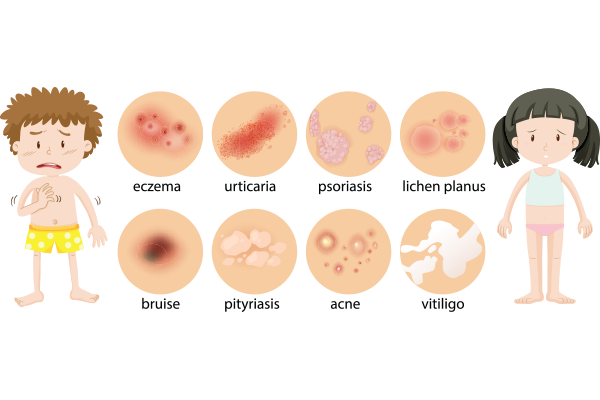
Eczema is more than just dry or itchy skin. For many children, it’s an ongoing battle that affects their sleep, confidence, and daily comfort. If you’re a parent trying to navigate the ups and downs of eczema treatment, you’re not alone. Childhood eczema—also known as atopic dermatitis—is one of the most common skin conditions among young ones. The good news? With awareness and the right care, it’s highly manageable.
In this blog, we’ll explore the causes, triggers, and both medical and natural eczema remedies in a way that’s practical, parent-friendly, and engaging.
Synopsis
What Is Childhood Eczema?
Childhood eczema is a chronic skin condition that causes dry, inflamed, and itchy patches of skin. It often starts in babies and toddlers, though some children outgrow it while others may continue to experience flare-ups into their teens.
The condition occurs due to a combination of genetic and environmental factors. If eczema, asthma, or hay fever runs in your family, your child is more likely to develop it.

Common Causes and Risk Factors
Understanding the root causes helps in tailoring the best child eczema treatment. Common causes include:
-
Genetics: A strong family history of eczema or other allergic conditions.
-
Weakened skin barrier: Leading to dryness and increased sensitivity.
-
Immune overreaction: Even mild irritants can trigger an immune response.
-
Environmental factors: Exposure to harsh chemicals, temperature changes, and allergens.
More Reads: 7 Tips to Take Care of Dry Skin
Everyday Triggers to Watch Out For
Knowing what sets off your child’s eczema is key to prevention. Here’s a simple table to help you identify and avoid the most common triggers:
|
Trigger |
Why It Matters |
Tips to Avoid |
|
Soaps and detergents |
Contain harsh chemicals that irritate the skin |
Use fragrance-free, hypoallergenic products |
|
Heat and sweating |
Triggers itching and flare-ups |
Dress your child in breathable fabrics |
|
Dust mites and pet dander |
Common allergens that aggravate symptoms |
Clean regularly, consider air purifiers |
|
Wool or synthetic fabrics |
Can cause friction and irritation |
Choose soft cotton clothing |
|
Emotional stress |
Can worsen the immune response |
Help your child manage stress through play |
Foods That Cause Eczema
While not all eczema is food-related, some children do react to certain foods. The most common foods that cause eczema flare-ups include:
-
Cow’s milk and dairy
-
Eggs
-
Soy
-
Wheat
-
Peanuts and other nuts
-
Shellfish
Elimination diets should only be attempted under professional supervision. Keep a food diary to spot patterns and consult with a paediatrician or allergist.
Building a Skin-Friendly Routine
Creating a consistent skincare routine is one of the most effective eczema remedies:
-
Moisturise often: Use thick, unscented moisturisers at least twice daily.
-
Gentle bathing: Bathe with lukewarm water, no more than 10–15 minutes, and avoid bubble baths.
-
Pat dry, don’t rub: Gently dry your child’s skin with a soft towel after a bath and immediately apply moisturiser.
-
Dress smart: Choose soft cotton fabrics and layer wisely to avoid overheating.
Medical Options for Eczema Treatment
If the condition becomes more severe or persistent, there are a number of effective eczema treatment options available:
-
Topical corticosteroids for flare-ups
-
Calcineurin inhibitors as a steroid-free alternative
-
Oral antihistamines for controlling the itch
-
Wet wrap therapy for soothing and hydration
-
Phototherapy or immune-modulating treatments for advanced cases
Always consult a dermatologist to build a tailored child eczema treatment plan based on your child’s age, severity, and health history.
More Reads: Digestive Problems In Children: What Parents Need To Know
Eczema Home Remedies Worth Trying
In addition to medical care, some gentle eczema home remedies can support healing:
1. Coconut Oil
This natural oil is a favourite among parents of eczema-prone children. It contains lauric acid, which has antimicrobial and moisturising properties. Applying a thin layer of virgin coconut oil to damp skin helps seal in moisture, reduce itchiness, and calm inflamed areas. It’s especially useful after bath time.
2. Oatmeal Baths
Colloidal oatmeal (finely ground oats) is a proven remedy for soothing irritated, itchy skin. It forms a protective barrier over the skin and helps to lock in moisture. Simply add 1–2 cups of colloidal oatmeal to lukewarm bath water and let your child soak for 10–15 minutes. It’s a gentle and calming ritual that can become part of your child’s evening routine.
3. Aloe Vera Gel
Known for its cooling and anti-inflammatory properties, aloe vera gel is great for relieving redness and itching. Look for pure, unscented aloe vera gel or extract it directly from a fresh aloe leaf. Apply a small amount to affected areas as needed—especially during warmer weather when heat aggravates eczema.
4. Cold Compresses
When flare-ups cause extreme itching or discomfort, a cold compress can bring quick relief. Soak a clean cloth in cold water, wring it out, and place it on the irritated area for 5–10 minutes. This not only reduces itching but also helps lower inflammation without the need for medication.
5. Sunflower Seed Oil
Unlike coconut oil, which is antibacterial, sunflower seed oil is prized for its ability to strengthen the skin’s natural barrier. It’s rich in linoleic acid, which supports skin hydration and improves overall resilience. Gently massage a few drops onto damp skin once or twice a day.
6. Humidifiers in Dry Seasons
If your home environment is dry—especially during winter—using a humidifier can help maintain skin hydration. Dry air can strip moisture from the skin, worsening eczema symptoms. A cool-mist humidifier in your child’s bedroom can make a big difference overnight.
7. Calendula Cream
This gentle herb-based cream has anti-inflammatory properties and is often used for baby rashes and eczema. It’s available over the counter and may help soothe sore or cracked skin.
Try these remedies with caution and always perform patch tests to avoid adverse reactions.
More Reads: Understanding Childhood Anxiety: Signs and Treatment
Tips for Trying Natural Remedies Safely:
-
Always do a patch test: Apply a small amount of the remedy on a tiny area first and wait 24 hours to check for any reaction.
-
Use remedies consistently: Natural treatments take time, so use them regularly as part of your child’s skincare routine.
-
Talk to your doctor: Especially before introducing any new oils or creams—some natural products may not be suitable if your child has allergies or very sensitive skin.
When used wisely, eczema home remedies can work alongside medical treatments to create a holistic, soothing care routine that helps your child feel more comfortable in their skin—literally!
More Reads: A Parent's Guide to Urinary Tract Infection in Children
Conclusion
If your child’s eczema is persistent or worsening, professional intervention can make a world of difference. At Manipal Hospitals Patiala, our skilled paediatric dermatology expert offers personalised care plans, allergy testing, and the latest advancements in eczema treatment.
Whether you need advanced medical support or guidance on eczema home remedies, we’re here to help. Early care leads to lasting comfort.
Book an appointment with Manipal Hospitals Patiala today and take the first step toward healthy, happy skin for your child.
FAQ's
Common foods that cause eczema flare-ups include dairy, eggs, peanuts, soy, and wheat. However, not all children are affected the same way, so it’s important to track symptoms and consult a doctor.
No, eczema is not contagious. It’s a chronic skin condition caused by genetic and environmental factors.
Fragrance-free, thick emollients such as petroleum jelly, Eucerin, or Cetraben work well. Always moisturise after bathing.
Yes, emotional stress can contribute to eczema flare-ups by affecting the immune system.
Yes, some children benefit from eczema home remedies like oatmeal baths, coconut oil, or aloe vera. Always consult your doctor before trying new treatments.





















 6 Min Read
6 Min Read



















